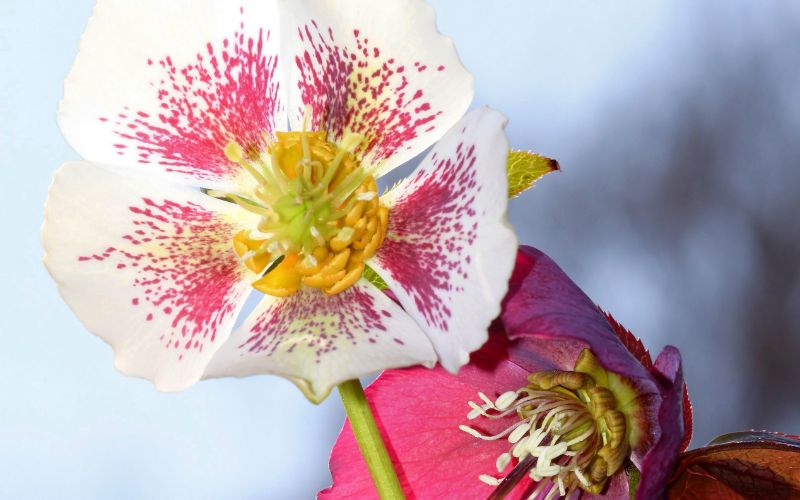If you’re lucky enough to have Lenten roses (Helleborus orientalis) in your garden, you know that they are a true delight.
These beautiful plants bloom in the middle of winter, bringing color and life to the coldest months.
But did you know that taking care of lenten roses is actually quite easy? With just a few simple tips, you can keep your lenten roses healthy and blooming for years to come.
Lenten rose is one of the easiest plants to grow. By keeping the soil moist and mulched in early winter you will encourage the plants to grow strongly with healthy blooms. You should plant Lenten roses in early fall or late spring in a location that has plenty of shade making sure that they are protected from strong winds.

What are Lenten roses?
Lenten roses are a type of flowering plant that belongs to the genus Helleborus.
These plants get their common name from the fact that they often bloom around Lent, which is the period of time between Ash Wednesday and Easter Sunday.
Lenten roses are herbaceous perennials, meaning that they die back to the ground each year and then regrow in the spring.
They have large, leathery leaves and beautiful, cup-shaped flowers that come in a variety of colors including white, pink, purple, and green.
How to take care of Lenten Roses?
Taking care of Lenten roses is actually quite easy. With just a few simple tips, you can keep your Lenten roses healthy and blooming for years to come.
Here are a few tips for taking care of lenten roses:
- water regularly, especially during dry spells
- fertilize every spring
- deadhead spent flowers
- remove yellow or dead leaves
- divide crowded plants every 3-4 years

Where should you plant Lenten roses?
Lenten roses are relatively easy to grow and they don’t require a lot of special care.
However, there are a few things to keep in mind when choosing a location for your plants.
First, Lenten roses prefer shady areas. They will tolerate some sun, but too much direct sunlight can scorch their leaves.
Second, Lenten roses need well-drained soil. If the soil is too wet, the roots will rot.
Third, Lenten roses should be protected from strong winds. Wind can damage the fragile flowers and leaves.
Fourth, Lenten roses do best in cooler climates. If you live in an area with very hot summers, it’s best to choose a spot that gets some afternoon shade.
Types of lenten roses
There are about 20 species of lenten roses, all of which are native to Europe and Asia.
The most common type of is Helleborus orientalis, which is also known as the black hellebore, or Christmas rose.
Lenten roses come in a variety of colors including white, pink, purple, and green.
The flowers are usually 2-3 inches wide and they bloom from late winter to early spring.
Where can you get lenten roses from?
Lenten roses are available from many nurseries and garden centers.
You can also find them online from a variety of retailers.
[amazon box=”B00NXVIJHE” template=”horizontal”]
If you want to get lenten roses from a nursery or garden center, be sure to choose a reputable one that has experience with these plants.
Lenten roses are relatively easy to grow, but they can be tricky to get started if you don’t have the right conditions.
When choosing Lenten roses online, be sure to read the descriptions carefully.
Some varieties are more difficult to grow than others, so it’s important to choose ones that will do well in your climate and soil type.
How much do lenten roses cost?
Lenten roses typically range in price from $10 to $30. The exact price will depend on the variety, size, and availability.
What are the benefits of lenten roses?
Lenten roses offer a number of benefits for gardeners.
First, they are relatively easy to grow and care for. S
econd, they are very tolerant of shade, making them a good choice for areas that don’t get a lot of sun.
Third, Lenten roses are early bloomers, often blooming in late winter or early spring.
This can provide a much-needed burst of color during a time when many other plants are still dormant.

When should you plant Lenten roses?
Lenten roses can be planted in either spring or fall. If you live in an area with very hot summers, it’s best to plant in the fall so that the plants have time to establish themselves before the heat arrives.
How often should you water Lenten roses?
Lenten roses need to be watered regularly, especially during dry spells.
They prefer soil that is moist but not soggy. Letting the soil dry out completely will cause the leaves to wilt and the flowers to drop off.
Should you fertilize Lenten roses?
Lenten roses benefit from being fertilized every spring.
A slow-release fertilizer is best so that you don’t have to worry about it washing away in the rain.




Should you deadhead Lenten roses?
Deadheading is the process of removing spent flowers. This can be done by simply breaking the stem off at the base of the flower or by using pruning shears to cut the stem just above a leaf joint.
Deadheading will encourage the plant to produce more flowers.
Should you remove yellow or dead leaves?
Lenten roses will naturally shed their leaves in the fall as they prepare for winter dormancy.
However, if you see any yellow or dead leaves during the growing season, it’s best to remove them so that the plant can focus its energy on producing new growth.
When should you divide Lenten roses?
Lenten roses can become overcrowded after a few years.
When this happens, they will produce fewer flowers and the overall health of the plant will decline.
To prevent this the plants should be divided every 3-4 years.
Dividing is best done in the fall so that the plants have time to recover before the growing season begins.

How long do Lenten roses live for?
Lenten roses are relatively long-lived plants.
With proper care, they can bloom for many years. In some cases, Lenten roses have been known to live for more than 20 years.
Do Lenten roses attract bees?
Lenten roses are not particularly attractive to bees.
However, they may be visited by bees if there are no other flowers blooming in the area.
What pests and diseases affect Lenten roses?
Lenten roses are relatively resistant to pests and diseases.
However, they can be affected by aphids, scale insects, and Japanese beetles.
If you see any of these pests on your plants, you can remove them by hand or treat them with an insecticidal soap.
Lenten roses are also susceptible to fungal diseases such as powdery mildew and blackspot. These can be controlled with fungicide treatments.

How to propagate lenten roses
Lenten roses can be propagated by seed, division, or cuttings.
Seed: Lenten roses can be grown from seed, but it is a slow and unpredictable method. Seeds should be sown in the fall and they will usually germinate the following spring.
Division: Division is the most common method of propagation. It is best done in the fall so that the plants have time to recover before the growing season begins.
To divide Lenten roses, simply dig up the entire plant and replant it in two or three different locations. Be sure to water the plants well after division.
Cuttings: Cuttings can be taken from both stems and leaves. Stem cuttings should be taken from new growth and they will usually root within a few weeks.
Leaf cuttings should be taken from healthy leaves and they will take longer to root, but they will often produce multiple plants.
Final Words
Lenten roses are beautiful, long-lived plants that are easy to care for.
With a little bit of knowledge and effort, you can enjoy their blooms for many years to come.






